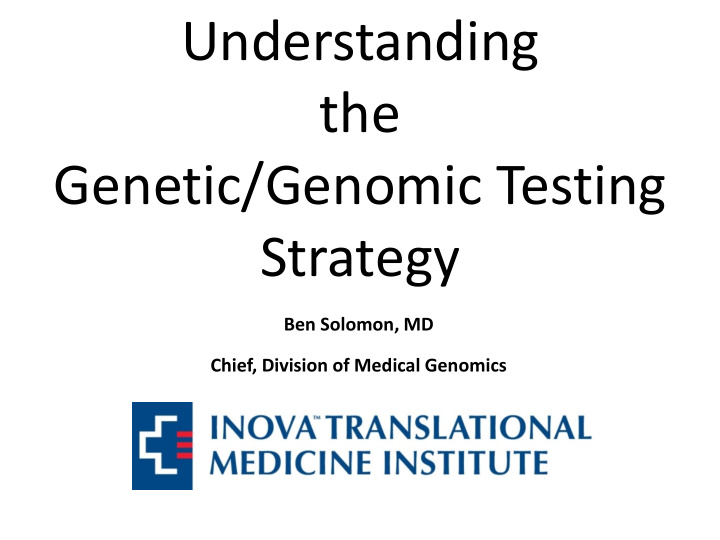



Understanding the Genetic/Genomic Testing Strategy Ben Solomon, MD Chief, Division of Medical Genomics
An Overall Theme!
Agenda • Background • Cases
Hospital System Six hospital + ambulatory • healthcare system Largest healthcare system in • Northern VA Two million patient visits/year • 20,000 deliveries/year • >5,000 newly diagnosed cancer • patients/year
ITMI • Started: 2010 • Overall goal: research on the integration of genomic information into the practice of medicine • ~100 members; ~1/3 Clinical, 1/3 IT/Informatic, 1/3 Lab
Division of Medical Genomics • 3 Physician-Scientists • 8 Genetic Counselors • 4 PhD Bioinformaticists, Molecular Biologists, etc.
I. Background
Current Events
Figuring out the Genetics
Ancient Times
Current Methods
Genomic Evolution 14 years from now 14 years ago Now ? Few dollars • ~$2.7 billion • ~$1,000 ? Few hours • ~13 years • ~1 week ? 1 (small) machine • 20+ centers (7 • 1 machine countries)
But It’s Complicated…
It’s Almost Impossible to Generalize
The Knowledge Base Keeps Expanding 200 180 160 140 11 New Hereditary Cancer Genes 120 100 80 60 40 20 0 Bornstein et al., [In Preparation]
Different Models!
And We Have to be Careful!
II. Cases
A. Cancer Examples
NCCN Guidelines
BRCA1 v mutation v v v 35
BRCA1 v mutation v v v 35
Breast v Cancer <50 yo v v v 35
Breast v Cancer <50 yo v v v 35 Previous BRCA1/BRCA2 testing negative (4 years ago)
Some v cancer v v v 35
Some v cancer v v v 65
Sometimes (Often Not) Obvious
Factors • Types of cancer (including pathology) • Ages of onset • Ancestry (e.g., Ashkenazi) • Availability and informativeness of family history • Patient preference (how extensive testing will be) • Previous genetic testing in family members • Urgency of testing (e.g., are the results needed prior to a surgical decision)? • Etc.
Choices and the Spiderman Effect • Specific familial (or ancestral) variant • BRCA1/BRCA2 • Large panel • Very large panel • Exome/Genome • Research participation • Etc.
Real Life Breast ca 60s 73 Bilat breast ca 40s OvaNext panel: NEGATIVE Breast ca 48 OvaNext panel: PALB2+
Real Life Breast ca, Breast ca 60s 70s age unknown Ovarian ca 70s ATM+ Ovarian ca 68 Ovarian ca 50s BRCA1/2 - OvaNext panel: RAD51D+ Breast ca 37 OvaNext panel: ATM+
B. Congenital Examples
Current Practice Khromykh et al. Molec Syndromol 2015
ASHG Position Statement (Botkin, AJHG 2015)
My Interpretation • If a targeted test is available use it • If a limited panel exists, use it • It’s OK to get the limited panel from genomic sequencing • Starting with genomic sequencing can be justified in some situations
Patient • IUGR, oligohydramnios • Delivery at 34 3/7 weeks • Hypoaldosteronism • Hypercalciuria • Sagittal craniosynostosis • Renal U/S: Grade II hydronephrosis • Echo: small ASD, PDA Bodian et al. MGGM 2014
Testing • Prenatal: increased risk of Down syndrome • CVS: 46,XY • Normal postnatal testing: microarray, 7- dehydroxycholesterol, TORCH testing, H19 methylation and uniparental disomy for chromosome 7 (Russell-Silver)
Just In Case Things Seemed Easy…
Thank You
Recommend
More recommend